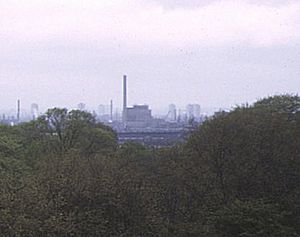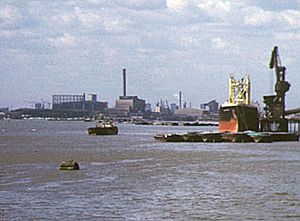Blackwall Point Power Station facts for kids
Quick facts for kids Blackwall Point Power Station |
|
|---|---|

Blackwall Point Power Station from Greenwich Park, 1973
|
|
| Country | England |
| Location | Greenwich, London |
| Coordinates | 51°29′52″N 0°00′41″E / 51.497800°N 0.011500°E |
| Status | Decommissioned and demolished |
| Construction began | 1900 & 1947 |
| Commission date | 1900 & 1951 |
| Decommission date | 1947 & 1984 |
| Owner(s) | Blackheath and Greenwich Electric Light Co. subsequently the South Metropolitan Electric Light and Power Co., then the County of London Electric Lighting Co. British Electricity Authority (1948–1955) Central Electricity Authority (1955–1957) Central Electricity Generating Board (1958–1984) |
| Operator(s) | Operated by owner |
| grid reference TQ3961079623 | |
Blackwall Point Power Station was a big building in London that used Coal to make electricity. It was located on the Greenwich Peninsula, right by the River Thames. There were actually two power stations on this spot. The first one opened in 1900, and a newer, bigger one replaced it in 1951. This second station helped power homes and businesses in London for over 30 years before it closed down in 1984.
How Blackwall Point Power Station Made Power
The very first power station at Blackwall Point started making electricity in 1900. It was built by a company called the Blackheath and Greenwich Electric Light Co. This early station could make enough power for about 15,000 homes. It closed in 1947.
A brand new power station was planned to take its place. This new station was designed to use only powdered coal. Coal was brought to the station by boats on the river. It was then ground into a fine powder. This powder was blown into a furnace by fans.
The new power station opened in 1952. It had three large machines called turbo-alternators. Each machine could make 30 megawatts (MW) of electricity. This meant the station could make a total of 90 MW of power. The machines were made by the English Electric Company.
To make electricity, the station used three large boilers. These boilers heated water to create very hot steam. This steam then spun the turbines, which were connected to the alternators to make electricity. The water used for cooling came from the River Thames. In 1954, the station used 167,000 tons of coal!
The first electricity-making machine started working in the summer of 1951. The other machines were ready by the spring of 1952. The power station was managed by different groups over the years. These included the British Electricity Authority and later the Central Electricity Generating Board.
How Much Electricity Was Made?
The graph below shows how much electricity Blackwall Point Power Station made each year. The numbers are in GWh, which stands for gigawatt-hours. This is a way to measure huge amounts of electricity. You can see how the amount of power changed over time.
Blackwell Point annual electricity output GWh.<graph>{ "version": 2, "width": 900, "height": 300, "data": [ { "name": "table", "values": [ { "x": 1964, "y": 1759 }, { "x": 1965, "y": 1475 }, { "x": 1966, "y": 1126 }, { "x": 1967, "y": 1139 }, { "x": 1968, "y": 1239 }, { "x": 1969, "y": 1307 }, { "x": 1970, "y": 961 }, { "x": 1971, "y": 1321 }, { "x": 1972, "y": 1701 }, { "x": 1973, "y": 1448 }, { "x": 1974, "y": 1264 }, { "x": 1975, "y": 1069 }, { "x": 1976, "y": 382 }, { "x": 1977, "y": 361 }, { "x": 1978, "y": 506 }, { "x": 1979, "y": 494 }, { "x": 1980, "y": 408 }, { "x": 1981, "y": 343 }, { "x": 1982, "y": 209 }, { "x": 1983, "y": 172 }, { "x": 1984, "y": 14 }, { "x": 1985, "y": 0 }, { "x": 1961, "y": 364 }, { "x": 1955, "y": 326 }, { "x": 1956, "y": 363 }, { "x": 1957, "y": 339 }, { "x": 1958, "y": 336 }, { "x": 1959, "y": 345 }, { "x": 1954, "y": 306 }, { "x": 1962, "y": 338 }, { "x": 1963, "y": 360 }, { "x": 1946, "y": 15 } ] } ], "scales": [ { "name": "x", "type": "ordinal", "range": "width", "zero": false, "domain": { "data": "table", "field": "x" } }, { "name": "y", "type": "linear", "range": "height", "nice": true, "domain": { "data": "table", "field": "y" } } ], "axes": [ { "type": "x", "scale": "x" }, { "type": "y", "scale": "y" } ], "marks": [ { "type": "rect", "from": { "data": "table" }, "properties": { "enter": { "x": { "scale": "x", "field": "x" }, "y": { "scale": "y", "field": "y" }, "y2": { "scale": "y", "value": 0 }, "fill": { "value": "steelblue" }, "width": { "scale": "x", "band": "true", "offset": -1 } } } } ] }</graph>
When Did It Close Down?
Blackwall Point Power Station stopped making electricity on October 26, 1981. Its power-making ability was 86 MW when it closed. The entire power station building was taken down, or "demolished," in 1987.
Today, if you visit the area, the only part of the station you can still see is the old pier. This pier was used to unload coal from ships on the River Thames.


